
In rail transport, distributed power (DP) is a generic term referring to the physical distribution—at intermediate points throughout the length of a train—of separate motive power groups. Such "groups" may be single units or multiple consists, and are remotely controlled from the leading locomotive. The practice allows locomotives to be placed anywhere within the length of a train when standard multiple-unit (MU) operation is impossible or impractical. DP can be achieved by wireless or wired (trainlined) means. Wired systems now provided by various suppliers use the cabling already extant throughout an ECP train.
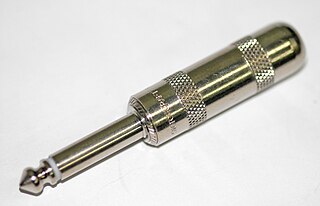
A phone connector, also known as phone jack, audio jack, headphone jack or jack plug, is a family of electrical connectors typically used for analog audio signals. The standard is that a plug will connect with a jack.
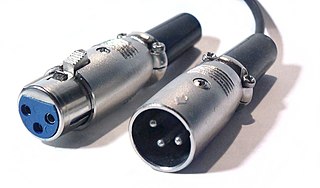
The XLR connector is a type of electrical connector primarily found on professional audio, video, and stage lighting equipment. The connectors are circular in design and have between three and seven pins. They are most commonly associated with balanced audio interconnection, including AES3 digital audio, but are also used for lighting control, low-voltage power supplies, and other applications. XLR connectors are available from a number of manufacturers and are covered by an international standard for dimensions, IEC 61076-2-103.
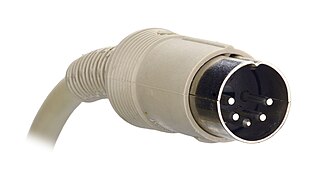
The DIN connector is an electrical connector that was originally standardized in the early 1970s by the Deutsches Institut für Normung (DIN), the German national standards organization. There are DIN standards for various different connectors.

A power cord, line cord, or mains cable is an electrical cable that temporarily connects an appliance to the mains electricity supply via a wall socket or extension cord. The terms are generally used for cables using a power plug to connect to a single-phase alternating current power source at the local line voltage. The terms power cable, mains lead, flex or kettle lead are also used. A lamp cord is a light-weight, ungrounded, single-insulated two-wire cord used for small loads such as a table or floor lamp.

The International Union of Railways is an international rail transport industry body.
A distribution board is a component of an electricity supply system that divides an electrical power feed into subsidiary circuits while providing a protective fuse or circuit breaker for each circuit in a common enclosure. Normally, a main switch, and in recent boards, one or more residual-current devices (RCDs) or residual current breakers with overcurrent protection (RCBOs) are also incorporated.

IEC 60309 is a series of international standards from the International Electrotechnical Commission (IEC) for "plugs, socket-outlets and couplers for industrial purposes". The maximum voltage allowed by the standard is 1000 V DC or AC; the maximum current, 800 A; and the maximum frequency, 500 Hz. The ambient temperature range is −25 °C to 40 °C.
Electrical wiring in the United Kingdom is commonly understood to be an electrical installation for operation by end users within domestic, commercial, industrial, and other buildings, and also in special installations and locations, such as marinas or caravan parks. It does not normally cover the transmission or distribution of electricity to them.

An intercom, also called an intercommunication device, intercommunicator, or interphone, is a stand-alone voice communications system for use within a building or small collection of buildings, functioning independently of the public telephone network. Intercoms are generally mounted permanently in buildings and vehicles. Intercoms can incorporate connections to public address loudspeaker systems, walkie talkies, telephones, and to other intercom systems. Some intercom systems incorporate control of devices such as signal lights and door latches.

In telecommunications, structured cabling is building or campus cabling infrastructure that consists of a number of standardized smaller elements called subsystems. Structured cabling components include twisted pair and optical cabling, patch panels and patch cables.

In rail transport, head-end power (HEP), also known as electric train supply (ETS), is the electrical power distribution system on a passenger train. The power source, usually a locomotive at the front or 'head' of a train, provides the electricity used for heating, lighting, electrical and other 'hotel' needs. The maritime equivalent is hotel electric power. A successful attempt by the London, Brighton and South Coast Railway in October 1881 to light the passenger cars on the London to Brighton route heralded the beginning of using electricity to light trains in the world.
Push–pull is a configuration for locomotive-hauled trains, allowing them to be driven from either end of the train, whether having a locomotive at each end or not.

The E.412 class is a batch of multi-role electric locomotives built for the mountain lines, particularly for the northern Italian lines of the Brenner pass. They are known as Brenner or Brennerlok locomotives. 28 units from both the groups have been acquired by Trenitalia, as part of a process of simplifying rail operation between Italy, Switzerland, Austria and Germany. The locomotives are qualified for running on French rails, too, making the E.412s potentially fit for service on most European lines except the high-speed rail lines.

A stage pin connector, also known as a grounded stage pin (GSP) or grounded pin connector (GPC), is a standard cable type for theatrical lighting in North America and in many countries in the theatre world.
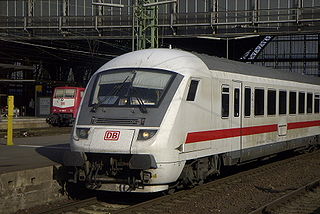
A control car, cab car, control trailer, or driving trailer is a generic term for a non-powered railroad (US) or railway (UIC) vehicle that can control operation of a train at the end, opposite to the position of the locomotive. They can be used with diesel or electric motive power, allowing push-pull operation without the use of an additional locomotive. They can also be used with a power car or a railcar. In a few cases control cars were used with steam locomotives, especially in Germany and France.

A modular connector is a type of electrical connector for cords and cables of electronic devices and appliances, such as in computer networking, telecommunication equipment, and audio headsets.
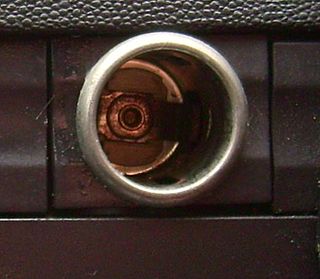
An automobile auxiliary power outlet in an automobile was initially designed to power an electrically heated cigarette lighter, but became a de facto standard DC connector to supply electrical power for portable accessories used in or near an automobile directly from the vehicle's electrical system. Such include mobile phone chargers, cooling fans, portable fridges, electric air pumps, and power inverters.
The train communication network (TCN) is a hierarchical combination of two fieldbus for data transmission within trains. It consists of the Multifunction Vehicle Bus (MVB) inside each vehicle and of the Wire Train Bus (WTB) to connect the different vehicles. The TCN components have been standardized in IEC 61375.
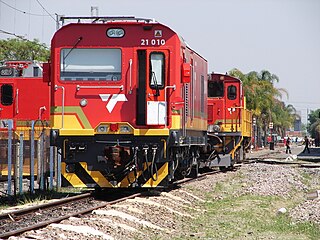
The Transnet Freight Rail Class 21E of 2014 is a South African electric locomotive.
















